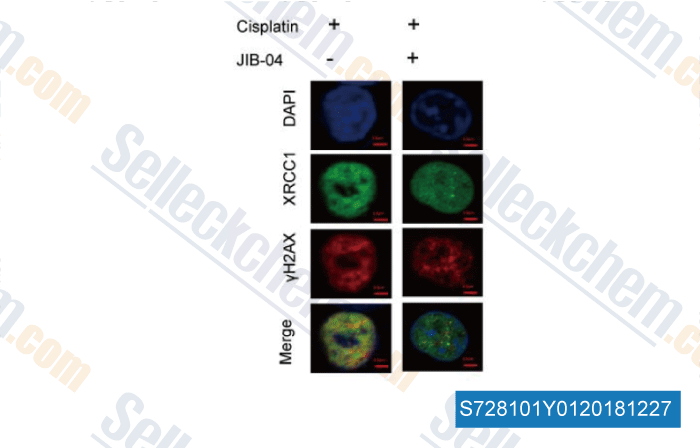|
Toll Free: (877) 796-6397 -- USA and Canada only -- |
Fax: +1-832-582-8590 Orders: +1-832-582-8158 |
Tech Support: +1-832-582-8158 Ext:3 Please provide your Order Number in the email. |
Technical Data
| Formula | C17H13ClN4 |
||||||
| Molecular Weight | 308.76 | CAS No. | 199596-05-9 | ||||
| Solubility (25°C)* | In vitro | DMSO | 61 mg/mL (197.56 mM) | ||||
| Water | Insoluble | ||||||
| Ethanol | Insoluble | ||||||
| In vivo (Add solvents to the product individually and in order) |
|
||||||
|
* <1 mg/ml means slightly soluble or insoluble. * Please note that Selleck tests the solubility of all compounds in-house, and the actual solubility may differ slightly from published values. This is normal and is due to slight batch-to-batch variations. * Room temperature shipping (Stability testing shows this product can be shipped without any cooling measures.) |
|||||||
Preparing Stock Solutions
Biological Activity
| Description | JIB-04 (NSC 693627) is a pan-selective Jumonji histone demethylase inhibitor with IC50 of 230, 340, 855, 445, 435, 1100, and 290 nM for JARID1A, JMJD2E, JMJD3, JMJD2A, JMJD2B, JMJD2C, and JMJD2D in cell-free assays, respectively. JIB‑04 also induces cell apoptosis. | |||||||||||
|---|---|---|---|---|---|---|---|---|---|---|---|---|
| Targets |
|
|||||||||||
| In vitro | JIB-04 induces transcriptional changes in a cancer-selective manner, including the downregulation of proliferative genes and the upregulation of the anti-proliferative/pro-apoptotic genes. JIB-04 blocks growth of lung and prostate cancer lines with IC50 as low as 10 nM, while produces less anti-proliferative activities on HBECs and PrSCs/PrECs. [1] | |||||||||||
| In vivo | In two separate xenograft mouse models (H358 or A549), JIB-04 diminishes tumor growth, lowers Jumonji histone demethylase activity in tumors, and prolongs cancer survival. [1] |
Protocol (from reference)
| Kinase Assay: |
|
|---|---|
| Cell Assay: |
|
| Animal Study: |
|
Customer Product Validation

-
Data from [Data independently produced by , , The journal of biological chemistry, 2016, 291(21):11083-11093.]

-
Data from [Data independently produced by , , Int J Biol Sci, 2018, 14(9):1122-1132]
Selleck's JIB-04 has been cited by 21 publications
| Heterogeneity-driven phenotypic plasticity and treatment response in branched-organoid models of pancreatic ductal adenocarcinoma [ Nat Biomed Eng, 2024, 10.1038/s41551-024-01273-9] | PubMed: 39658630 |
| Methionine restriction promotes cGAS activation and chromatin untethering through demethylation to enhance antitumor immunity [ Cancer Cell, 2023, 41(6):1118-1133.e12] | PubMed: 37267951 |
| JIB-04 Has Broad-Spectrum Antiviral Activity and Inhibits SARS-CoV-2 Replication and Coronavirus Pathogenesis [ mBio, 2022, 13(1):e0337721] | PubMed: 35038906 |
| Confined migration induces heterochromatin formation and alters chromatin accessibility [ iScience, 2022, 25(9):104978] | PubMed: 36117991 |
| Sensitization of Resistant Breast Cancer Cells with a Jumonji Family Histone Demethylase Inhibitor [ Cancers (Basel), 2022, 14(11)2631] | PubMed: 35681611 |
| Inhibitors of Jumonji C domain-containing histone lysine demethylases overcome cisplatin and paclitaxel resistance in non-small cell lung cancer through APC/Cdh1-dependent degradation of CtIP and PAF15 [ Cancer Biol Ther, 2022, 23(1):65-75] | PubMed: 35100078 |
| A siRNA screening of UBE2 family demonstrated that UBE2R1 had a high repressive effect on HIV Tat protein [ Biochem Biophys Rep, 2022, 32:101366] | PubMed: 36275929 |
| Upregulation of deubiquitinase USP7 by transcription factor FOXO6 promotes EC progression via targeting the JMJD3/CLU axis [ Mol Ther Oncolytics, 2021, 20:583-595] | PubMed: 33768140 |
| Hypoxia Stimulates SUMOylation-Dependent Stabilization of KDM5B [ Front Cell Dev Biol, 2021, 9:741736] | PubMed: 34977006 |
| IOX1 activity as sepsis therapy and an antibiotic against multidrug-resistant bacteria [ Sci Rep, 2021, 11(1):2942] | PubMed: 33536477 |
RETURN POLICY
Selleck Chemical’s Unconditional Return Policy ensures a smooth online shopping experience for our customers. If you are in any way unsatisfied with your purchase, you may return any item(s) within 7 days of receiving it. In the event of product quality issues, either protocol related or product related problems, you may return any item(s) within 365 days from the original purchase date. Please follow the instructions below when returning products.
SHIPPING AND STORAGE
Selleck products are transported at room temperature. If you receive the product at room temperature, please rest assured, the Selleck Quality Inspection Department has conducted experiments to verify that the normal temperature placement of one month will not affect the biological activity of powder products. After collecting, please store the product according to the requirements described in the datasheet. Most Selleck products are stable under the recommended conditions.
NOT FOR HUMAN, VETERINARY DIAGNOSTIC OR THERAPEUTIC USE.
